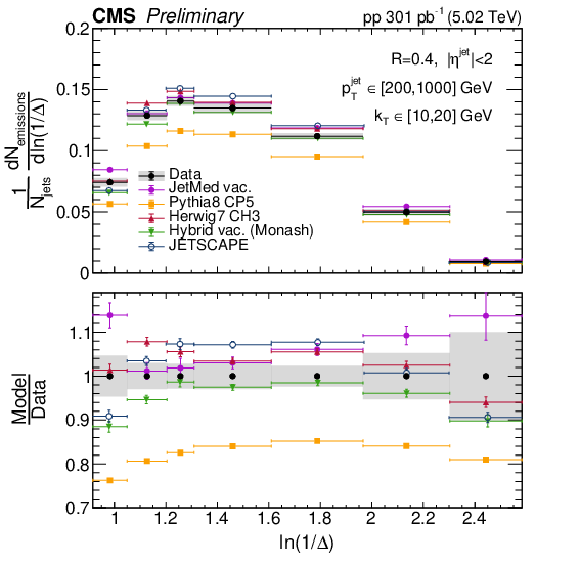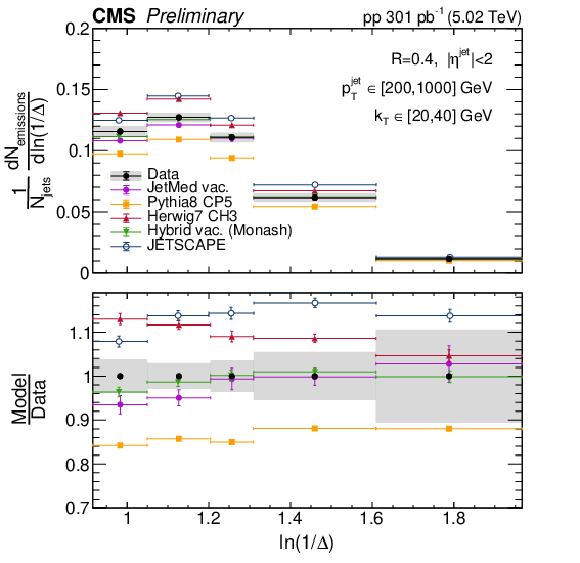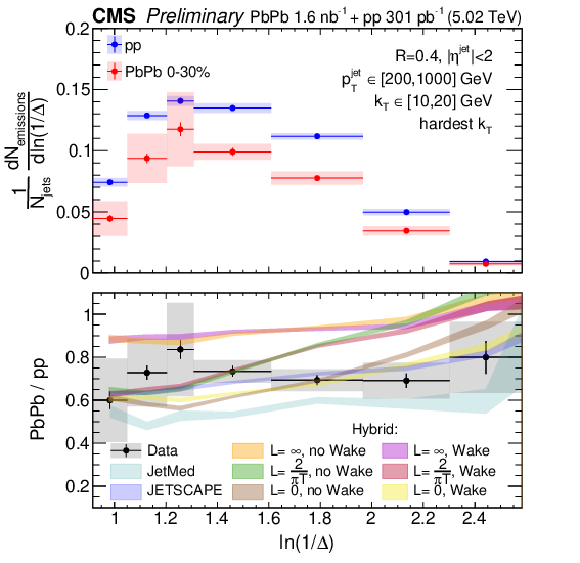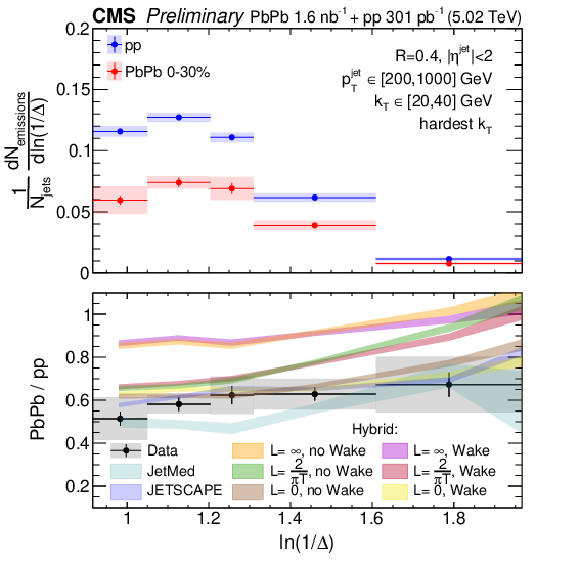

Compact Muon Solenoid
LHC, CERN
| CMS-PAS-HIN-24-016 | ||
| First $ k_{\mathrm{T}} $ scan of the Lund jet plane in heavy-ion collisions to test the factorization of the vacuum and medium parton shower | ||
| CMS Collaboration | ||
| 18 February 2025 | ||
| Abstract: This note presents the first relative transverse momentum ($ k_{\mathrm{T}} $) scan of the Lund jet plane for high-energy jets in lead-lead (Pb-Pb) collisions at the LHC at a nucleon-nucleon center-of-mass energy of 5.02 TeV. We report the fully corrected angular distribution of the primary emissions with the highest $ k_{\mathrm{T}} $ in two different ranges of $ k_{\mathrm{T}} $ for anti-$ k_{\mathrm{T}} $ jets with distance parameter $ R= $ 0.4 and transverse momentum in the range 200 $ < p_{\mathrm{T}}^\text{jet} < $ 1000 GeV. The analysis uses Pb-Pb and pp data samples with integrated luminosities of 1.7 nb$^{-1}$ and 301 pb$^{-1}$, respectively, collected with the CMS experiment in 2018 and 2017. A $ k_{\mathrm{T}} $ scan of the Lund plane allows us to explore the scale dependence of jet quenching phenomena. Our measurement was designed to test the validity of the assumed factorization between the early vacuum and QGP-induced stages of jet evolution in heavy-ion collisions, which is an underlying assumption of several jet quenching models and has not yet been experimentally proven. The reported angular distribution of emissions at high $ k_{\mathrm{T}} $ have a similar shape in pp and Pb-Pb, and this is consistent with the emissions being part of the early and vacuum-like regime of the jet evolution in Pb-Pb. | ||
| Links: CDS record (PDF) ; Physics Briefing ; CADI line (restricted) ; | ||
| Figures | |

png pdf |
Figure 1:
Left: schematic diagram of the Cambridge-Aachen primary declusterings, i.e., following the hardest subjet at each step of the declustering process. The softer subjets at each step are used as proxies for the emissions whose kinematics can be mapped onto the LJP. In the analysis, the emission with the highest $ k_{\mathrm{T}} $ value is used. Right: distinct regions of the LJP with the expected sensitivities of the jet shower evolution as the jet shower traverses the quark-gluon plasma. The dashed diagonal line represents the characteristic length scale where the formation time of the emissions is longer than the lifetime of the plasma. The dotted vertical line represents the expected manifestation of color coherence effects at a critical angle $ \theta_c $, below which the plasma would not be able to separate this. |

png pdf |
Figure 2:
Particle-level angular distributions ($ \text{ln}(1/\Delta) $) of hardest $ k_{\mathrm{T}} $ emissions in the ranges $ k_{\mathrm{T}} \in [10,20] $ GeV (left) and $ k_{\mathrm{T}} \in [20,40] $ GeV (right) in pp collisions. A comparison is made with model predictions by PYTHIA8 CP5 tune, HERWIG 7 CH3 tune, JetMed and Hybrid vacuum (modified PYTHIA8 Monash tune), as well as JETSCAPE, with their ratios to data shown in the bottom panels. The uncertainties on the models are statistical. The shaded region represents the total uncertainty in data. |

png pdf |
Figure 2-a:
Particle-level angular distributions ($ \text{ln}(1/\Delta) $) of hardest $ k_{\mathrm{T}} $ emissions in the ranges $ k_{\mathrm{T}} \in [10,20] $ GeV (left) and $ k_{\mathrm{T}} \in [20,40] $ GeV (right) in pp collisions. A comparison is made with model predictions by PYTHIA8 CP5 tune, HERWIG 7 CH3 tune, JetMed and Hybrid vacuum (modified PYTHIA8 Monash tune), as well as JETSCAPE, with their ratios to data shown in the bottom panels. The uncertainties on the models are statistical. The shaded region represents the total uncertainty in data. |

png pdf |
Figure 2-b:
Particle-level angular distributions ($ \text{ln}(1/\Delta) $) of hardest $ k_{\mathrm{T}} $ emissions in the ranges $ k_{\mathrm{T}} \in [10,20] $ GeV (left) and $ k_{\mathrm{T}} \in [20,40] $ GeV (right) in pp collisions. A comparison is made with model predictions by PYTHIA8 CP5 tune, HERWIG 7 CH3 tune, JetMed and Hybrid vacuum (modified PYTHIA8 Monash tune), as well as JETSCAPE, with their ratios to data shown in the bottom panels. The uncertainties on the models are statistical. The shaded region represents the total uncertainty in data. |

png pdf |
Figure 3:
Fully corrected hardest $ k_{\mathrm{T}} $ emission angular distributions ($ \text{ln}(1/\Delta) $) in the ranges $ k_{\mathrm{T}} \in [10,20] $ GeV (left) and $ k_{\mathrm{T}} \in [20,40] $ GeV (right) for pp and PbPb collisions of centrality 0-30%. The uncertainties are propagated as uncorrelated in the ratio (bottom panels). Each distribution is normalized to the total number of jets within $ p_{\mathrm{T}} \in [200,1000]$ GeV and $ |\eta| < $ 2. The ratio is compared with jet quenching model predictions by JetMed, JETSCAPE and Hybrid, which provides different medium resolution lengths ($ L $) and the inclusion/exclusion of backreacting medium particles (wake). The uncertainties on the models are statistical. The shaded regions in the data distributions represent the total uncertainty. |

png pdf |
Figure 3-a:
Fully corrected hardest $ k_{\mathrm{T}} $ emission angular distributions ($ \text{ln}(1/\Delta) $) in the ranges $ k_{\mathrm{T}} \in [10,20] $ GeV (left) and $ k_{\mathrm{T}} \in [20,40] $ GeV (right) for pp and PbPb collisions of centrality 0-30%. The uncertainties are propagated as uncorrelated in the ratio (bottom panels). Each distribution is normalized to the total number of jets within $ p_{\mathrm{T}} \in [200,1000]$ GeV and $ |\eta| < $ 2. The ratio is compared with jet quenching model predictions by JetMed, JETSCAPE and Hybrid, which provides different medium resolution lengths ($ L $) and the inclusion/exclusion of backreacting medium particles (wake). The uncertainties on the models are statistical. The shaded regions in the data distributions represent the total uncertainty. |

png pdf |
Figure 3-b:
Fully corrected hardest $ k_{\mathrm{T}} $ emission angular distributions ($ \text{ln}(1/\Delta) $) in the ranges $ k_{\mathrm{T}} \in [10,20] $ GeV (left) and $ k_{\mathrm{T}} \in [20,40] $ GeV (right) for pp and PbPb collisions of centrality 0-30%. The uncertainties are propagated as uncorrelated in the ratio (bottom panels). Each distribution is normalized to the total number of jets within $ p_{\mathrm{T}} \in [200,1000]$ GeV and $ |\eta| < $ 2. The ratio is compared with jet quenching model predictions by JetMed, JETSCAPE and Hybrid, which provides different medium resolution lengths ($ L $) and the inclusion/exclusion of backreacting medium particles (wake). The uncertainties on the models are statistical. The shaded regions in the data distributions represent the total uncertainty. |
| Tables | |

png pdf |
Table 1:
Lower and upper bounds of fractional uncertainties (in %) for each source in PbPb and pp collisions for both reported $ k_{\mathrm{T}} $ ranges. |
| Summary |
| We present the first momentum scale ($ k_{\mathrm{T}} $) scan of the Lund jet plane (LJP) in heavy ion collisions. This scan provides an experimental approach to validate the factorization hypothesis between vacuum and in-medium cascades. This is an underlying assumption in several jet quenching calculations, which lacks so far experimental confirmation. The unfolded angular distribution of the hardest splittings selected in two exclusive intervals of the splittings' relative momentum $ k_{\mathrm{T}} $ are compared in pp and in PbPb collisions. The comparison of the ratio with models suggests the observable does not depend on the medium response as implemented in the Hybrid model. The ratios are most consistent with vanishing resolution length in the Hybrid model and with the JETSCAPE model, which doesn't have an explicit implementation of color coherence. The ratios show a similar shape of the angular distribution in both collision systems, within the experimental uncertainties. This similarity suggests that the analysis isolates early vacuum-like emissions in PbPb collisions. |
| References | ||||
| 1 | W. Busza, K. Rajagopal, and W. van der Schee | Heavy ion collisions: the big picture and the big questions | Ann. Rev. Nucl. Part. Sci. 68 (2018) 339 | 1802.04801 |
| 2 | A. Adams et al. | Strongly correlated quantum fluids: ultracold quantum gases, quantum chromodynamic plasmas, and holographic duality | New J. Phys. 14 (2012) 115009 | 1205.5180 |
| 3 | CMS Collaboration | Overview of high-density QCD studies with the CMS experiment at the LHC | CMS-HIN-23-011 2405.10785 |
|
| 4 | L. Cunqueiro and A. M. Sickles | Studying the QGP with jets at the LHC and RHIC | Prog. Part. Nucl. Phys. 124 (2022) 103940 | 2110.14490 |
| 5 | L. Apolinàrio, Y.-J. Lee, and M. Winn | Heavy quarks and jets as probes of the QGP | Prog. Part. Nucl. Phys. 127 (2022) 103990 | 2203.16352 |
| 6 | M. Gyulassy and M. Plumer | Jet quenching in dense matter | PLB 243 (1990) 432 | hep-ph/9408344 |
| 7 | R. Baier et al. | Radiative energy loss of high-energy quarks and gluons in a finite volume quark-gluon plasma | NPB 483 (1997) 291 | hep-ph/9607355 |
| 8 | R. Baier et al. | Radiative energy loss and $ p_{\mathrm{T}} $ broadening of high-energy partons in nuclei | NPB 484 (1997) 265 | hep-ph/9608322 |
| 9 | J. Casalderrey-Solana and E. Iancu | Interference effects in medium-induced gluon radiation | JHEP 08 (2011) 015 | 1105.1760 |
| 10 | Y. Mehtar-Tani, C. A. Salgado, and K. Tywoniuk | Anti-angular ordering of gluon radiation in QCD media | PRL 106 (2011) 122002 | 1009.2965 |
| 11 | J. Casalderrey-Solana, Y. Mehtar-Tani, C. A. Salgado, and K. Tywoniuk | New picture of jet quenching dictated by color coherence | PLB 725 (2013) 357 | 1210.7765 |
| 12 | S. Cao and G.-Y. Qin | Medium response and jet-hadron correlations in relativistic heavy-ion collisions | Ann. Rev. Nucl. Part. Sci. 73 (2023) 205 | 2211.16821 |
| 13 | P. Caucal, E. Iancu, A. H. Mueller, and G. Soyez | Vacuum-like jet fragmentation in a dense QCD medium | PRL 120 (2018) 232001 | 1801.09703 |
| 14 | JETSCAPE Collaboration | Hard jet substructure in a multistage approach | Phys. Rev. C 110 (2024) 044907 | 2301.02485 |
| 15 | K. C. Zapp, F. Krauss, and U. A. Wiedemann | A perturbative framework for jet quenching | JHEP 03 (2013) 080 | 1212.1599 |
| 16 | A. Lifson, G. P. Salam, and G. Soyez | Calculating the primary Lund jet plane density | JHEP 10 (2020) 170 | 2007.06578 |
| 17 | F. A. Dreyer, G. P. Salam, and G. Soyez | The Lund jet plane | JHEP 12 (2018) 064 | 1807.04758 |
| 18 | Y. L. Dokshitzer, G. D. Leder, S. Moretti, and B. R. Webber | Better jet clustering algorithms | JHEP 08 (1997) 001 | hep-ph/9707323 |
| 19 | L. Cunqueiro et al. | Isolating perturbative QCD splittings in heavy-ion collisions | PRD 110 (2024) 014015 | 2311.07643 |
| 20 | H. A. Andrews et al. | Novel tools and observables for jet physics in heavy ion collisions | JPG 47 (2020) 065102 | 1808.03689 |
| 21 | ALICE Collaboration | Measurement of the primary Lund jet plane density in pp collisions at $ \sqrt{s} = \rm{13} $ TeV with ALICE | PoS EPS-HEP 364, 2022 link |
2111.00020 |
| 22 | CMS Collaboration | Measurement of the primary Lund jet plane density in proton-proton collisions at $ \sqrt{\textrm{s}} $ = 13 TeV | JHEP 05 (2024) 116 | CMS-SMP-22-007 2312.16343 |
| 23 | ATLAS Collaboration | Measurement of the Lund jet plane using charged particles in 13 TeV proton-proton collisions with the ATLAS detector | PRL 124 (2020) 222002 | 2004.03540 |
| 24 | A. J. Larkoski, S. Marzani, G. Soyez, and J. Thaler | Soft drop | JHEP 05 (2014) 146 | 1402.2657 |
| 25 | Y. Mehtar-Tani, A. Soto-Ontoso, and K. Tywoniuk | Dynamical grooming of QCD jets | PRD 101 (2020) 034004 | 1911.00375 |
| 26 | CMS Collaboration | Measurement of the splitting Function in pp and PbPb collisions at $ \sqrt{\smash[b]{s_{_{\mathrm{NN}}}}} = $ 5.02 TeV | PRL 120 (2018) 142302 | CMS-HIN-16-006 1708.09429 |
| 27 | CMS Collaboration | Measurement of the groomed jet mass in PbPb and pp collisions at $ \sqrt{\smash[b]{s_{_{\mathrm{NN}}}}}= $ 5.02 TeV | JHEP 10 (2018) 161 | CMS-HIN-16-024 1805.05145 |
| 28 | ALICE Collaboration | Exploration of jet substructure using iterative declustering in pp and PbPb collisions at LHC energies | PLB 802 (2020) 135227 | 1905.02512 |
| 29 | ALICE Collaboration | Measurement of the groomed jet radius and momentum splitting fraction in pp and PbPb collisions at $ \sqrt{\smash[b]{s_{_{\mathrm{NN}}}}} = $ 5.02 TeV | PRL 128 (2022) 102001 | 2107.12984 |
| 30 | ATLAS Collaboration | Measurement of substructure-dependent jet suppression in Pb+Pb collisions at 5.02 TeV with the ATLAS detector | Phys. Rev. C 107 (2023) 054909 | 2211.11470 |
| 31 | ALICE Collaboration | Search for quasi-particle scattering in the quark-gluon plasma with jet splittings in pp and Pb-Pb collisions at $ \sqrt{\smash[b]{s_{_{\mathrm{NN}}}}} = $ 5.02 TeV | 2409.12837 | |
| 32 | ATLAS Collaboration | Measurement of suppression of large-radius jets and its dependence on substructure in PbPb collisions at $ \sqrt{\smash[b]{s_{_{\mathrm{NN}}}}} = $ 5.02 TeV with the ATLAS detector | PRL 131 (2023) 172301 | 2301.05606 |
| 33 | M. van Beekveld et al. | A new standard for the logarithmic accuracy of parton showers | PRL 134 (2025) 011901 | 2406.02661 |
| 34 | CMS Collaboration | CMS luminosity measurement for the 2018 data-taking period at $ \sqrt{s} = $ 13 TeV | CMS Physics Analysis Summary, 2019 link |
CMS-PAS-LUM-18-002 |
| 35 | CMS Collaboration | Luminosity measurement in proton-proton collisions at 5.02 TeV in 2017 at CMS | CMS Physics Analysis Summary, 2021 CMS-PAS-LUM-19-001 |
CMS-PAS-LUM-19-001 |
| 36 | CMS Collaboration | The CMS experiment at the CERN LHC | JINST 3 (2008) S08004 | |
| 37 | CMS Collaboration | Development of the CMS detector for the CERN LHC Run 3 | JINST 19 (2024) P05064 | CMS-PRF-21-001 2309.05466 |
| 38 | CMS Collaboration | Performance of the CMS Level-1 trigger in proton-proton collisions at $ \sqrt{s} = $ 13 TeV | JINST 15 (2020) P10017 | CMS-TRG-17-001 2006.10165 |
| 39 | CMS Collaboration | The CMS trigger system | JINST 12 (2017) P01020 | CMS-TRG-12-001 1609.02366 |
| 40 | CMS Collaboration | Electron and photon reconstruction and identification with the CMS experiment at the CERN LHC | JINST 16 (2021) P05014 | CMS-EGM-17-001 2012.06888 |
| 41 | CMS Collaboration | Performance of the CMS muon detector and muon reconstruction with proton-proton collisions at $ \sqrt{s}= $ 13 TeV | JINST 13 (2018) P06015 | CMS-MUO-16-001 1804.04528 |
| 42 | CMS Collaboration | Description and performance of track and primary-vertex reconstruction with the CMS tracker | JINST 9 (2014) P10009 | CMS-TRK-11-001 1405.6569 |
| 43 | CMS Collaboration | Particle-flow reconstruction and global event description with the CMS detector | JINST 12 (2017) P10003 | CMS-PRF-14-001 1706.04965 |
| 44 | CMS Collaboration | Performance of reconstruction and identification of $ \tau $ leptons decaying to hadrons and $ \nu_\tau $ in pp collisions at $ \sqrt{s}= $ 13 TeV | JINST 13 (2018) P10005 | CMS-TAU-16-003 1809.02816 |
| 45 | CMS Collaboration | Jet energy scale and resolution in the CMS experiment in pp collisions at 8 TeV | JINST 12 (2017) P02014 | CMS-JME-13-004 1607.03663 |
| 46 | CMS Collaboration | Performance of missing transverse momentum reconstruction in proton-proton collisions at $ \sqrt{s} = $ 13 TeV using the CMS detector | JINST 14 (2019) P07004 | CMS-JME-17-001 1903.06078 |
| 47 | T. Sj$\text ö $strand et al. | An introduction to PYTHIA8.2 | Comput. Phys. Commun. 191 (2015) 159 | 1410.3012 |
| 48 | CMS Collaboration | Extraction and validation of a new set of CMS PYTHIA8 tunes from underlying-event measurements | EPJC 80 (2020) 4 | CMS-GEN-17-001 1903.12179 |
| 49 | S. Gieseke, P. Stephens, and B. Webber | New formalism for QCD parton showers | JHEP 12 (2003) 045 | hep-ph/0310083 |
| 50 | NNPDF Collaboration | Parton distributions for the LHC Run II | JHEP 04 (2015) 040 | 1410.8849 |
| 51 | B. R. Webber | A QCD model for jet fragmentation including soft gluon interference | NPB 238 (1984) 492 | |
| 52 | CMS Collaboration | Development and validation of HERWIG 7 tunes from CMS underlying-event measurements | EPJC 81 (2021) 312 | CMS-GEN-19-001 2011.03422 |
| 53 | GEANT4 Collaboration | GEANT 4---a simulation toolkit | NIM A 506 (2003) 250 | |
| 54 | I. P. Lokhtin and A. M. Snigirev | A model of jet quenching in ultrarelativistic heavy ion collisions and high-$ p_{\mathrm{T}} $ hadron spectra at RHIC | EPJC 45 (2006) 211 | hep-ph/0506189 |
| 55 | C. Loizides, J. Kamin, and D. d'Enterria | Improved Monte Carlo Glauber predictions at present and future nuclear colliders | Phys. Rev. C 97 (2018) 054910 | 1710.07098 |
| 56 | CMS Collaboration | Observation and studies of jet quenching in PbPb collisions at nucleon-nucleon center-of-mass energy $ \sqrt{\smash[b]{s_{_{\mathrm{NN}}}}} = $ 2.76 TeV | Phys. Rev. C 84 (2011) 024906 | CMS-HIN-10-004 1102.1957 |
| 57 | M. Cacciari, G. P. Salam, and G. Soyez | The anti-$ k_{\mathrm{T}} $ jet clustering algorithm | JHEP 04 (2008) 063 | 0802.1189 |
| 58 | P. Berta, M. Spousta, D. W. Miller, and R. Leitner | Particle-level pileup subtraction for jets and jet shapes | JHEP 06 (2014) 092 | 1403.3108 |
| 59 | O. Kodolova, I. Vardanyan, A. Nikitenko, and A. Oulianov | The performance of the jet identification and reconstruction in heavy ions collisions with CMS detector | EPJC 50 (2007) 117 | |
| 60 | ALICE Collaboration | Measurement of event background fluctuations for charged particle jet reconstruction in PbPb collisions at $ \sqrt{\smash[b]{s_{_{\mathrm{NN}}}}} = $ 2.76 TeV | JHEP 03 (2012) 053 | 1201.2423 |
| 61 | CMS Collaboration | Determination of jet energy calibration and transverse momentum resolution in CMS | JINST 6 (2011) P11002 | CMS-JME-10-011 1107.4277 |
| 62 | J. Mulligan and M. Ploskon | Identifying groomed jet splittings in heavy ion collisions | Phys. Rev. C 102 (2020) 044913 | 2006.01812 |
| 63 | G. D'Agostini | A multidimensional unfolding method based on Bayes' theorem | NIM A 362 (1995) 487 | 1010.0632 |
| 64 | T. Adye | Unfolding algorithms and tests using \textscRooUnfold | in PHYSTAT 2011 Workshop on Statistical Issues Related to Discovery Claims in Search Experiments and Unfolding, 2011 link |
1105.1160 |
| 65 | J. Bellm et al. | HERWIG 7.0/ HERWIG++ 3.0 release note | EPJC 76 (2016) 196 | 1512.01178 |
| 66 | J. Bellm et al. | HERWIG 7.2 release note | EPJC 80 (2020) 452 | 1912.06509 |
| 67 | J. Casalderrey-Solana et al. | A hybrid strong/weak coupling approach to jet quenching | JHEP 10 (2014) 019 | 1405.3864 |
| 68 | K. C. Zapp | JEWEL 2.0.0: directions for use | EPJC 74 (2014) 2762 | 1311.0048 |
| 69 | CMS Collaboration | Study of quark and gluon jet substructure in Z+jet and dijet events from pp collisions | JHEP 01 (2022) 188 | CMS-SMP-20-010 2109.03340 |
| 70 | CMS Collaboration | Study of jet quenching with isolated-photon+jet correlations in PbPb and pp collisions at $ \sqrt{\smash[b]{s_{_{\mathrm{NN}}}}} = $ 5.02 TeV | PLB 785 (2018) 14 | CMS-HIN-16-002 1711.09738 |
| 71 | P. Caucal | Jet evolution in a dense QCD medium | PhD thesis, Saclay, 2020 | 2010.02874 |
| 72 | J. Casalderrey-Solana et al. | Jet wake from linearized hydrodynamics | JHEP 05 (2021) 230 | 2010.01140 |
| 73 | JETSCAPE Collaboration | Multistage Monte-Carlo simulation of jet modification in a static medium | Phys. Rev. C 96 (2017) 024909 | 1705.00050 |
| 74 | P. Skands, S. Carrazza, and J. Rojo | Tuning PYTHIA8.1: the Monash 2013 tune | EPJC 74 (2014) 3024 | 1404.5630 |
| 75 | S. Cao and A. Majumder | Nuclear modification of leading hadrons and jets within a virtuality ordered parton shower | Phys. Rev. C 101 (2020) 024903 | 1712.10055 |
| 76 | CMS Collaboration | Measurement of the differential $ \mathrm{t} \overline{\mathrm{t}} $ production cross section as a function of the jet mass and extraction of the top quark mass in hadronic decays of boosted top quarks | EPJC 83 (2023) 560 | CMS-TOP-21-012 2211.01456 |
| 77 | Z. Hulcher, D. Pablos, and K. Rajagopal | Resolution effects in the hybrid strong/weak coupling model | JHEP 03 (2018) 010 | 1707.05245 |
| 78 | S. Cao, T. Luo, G.-Y. Qin, and X.-N. Wang | Heavy and light flavor jet quenching at RHIC and LHC energies | PLB 777 (2018) 255 | 1703.00822 |
| 79 | CMS Collaboration | Girth and groomed radius of jets recoiling against isolated photons in lead-lead and proton-proton collisions at $ \sqrt{\smash[b]{s_{_{\mathrm{NN}}}}} = $ 5.02 TeV | PLB 861 (2025) 139088 | CMS-HIN-23-001 2405.02737 |

|
Compact Muon Solenoid LHC, CERN |

|

|

|

|

|

|